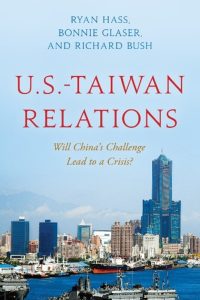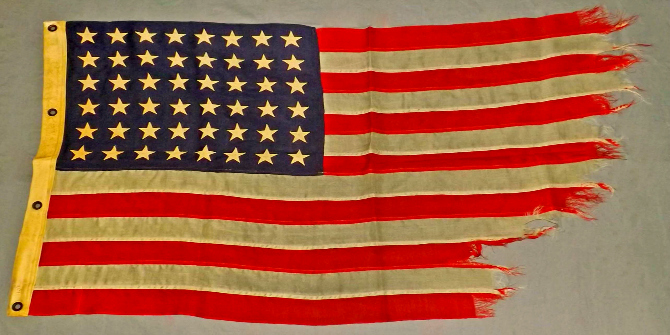In U.S.-Taiwan Relations: Will China’s Challenge Lead to a Crisis?, Ryan Hass, Bonnie Glaser and Richard Bush examine the likelihood of a Chinese invasion of Taiwan. While many commentators believe such an invasion is inevitable, the authors write that it is dependent on political developments in China, Taiwan and the United States. For Gray Sergeant, the book draws a succinct history of the issue with a calm analysis which balances often alarmist media narratives of the China-Taiwan relationship.
U.S.-Taiwan Relations: Will China’s Challenge Lead to a Crisis? Ryan Hass, Bonnie Glaser and Richard Bush. Brookings Institution Press. 2023.

If the international media, and top-ranking American military men, are anything to go by, then the question posed in the title of U.S.-Taiwan Relations: Will China’s Challenge Lead to a Crisis? (2023) has a very definite answer. Yes – and sooner rather than later.
In his valedictory testimony to the Senate armed services committee in the spring 2021 the outgoing commander of US Indo-Pacific Command, Admiral Philip Davidson, expressed his concern that the People’s Republic of China (PRC) was accelerating its plans to supplant the US as the No.1 global hegemon. He went on to warn: “Taiwan is clearly one of [the PRC’s] ambitions before that. And I think the threat is manifest during this decade, in fact, in the next six years,”. The “Davidson Window”, as it has been dubbed, has been used widely to bolster predictions of a Chinese attack on Taiwan by 2027.
Such determinism is rejected by Ryan Hass, Bonnie Glaser and Richard Bush, all of whom are seasoned observers of politics across the Taiwan Strait as both scholars and practitioners. For them, it really is a question of if China would invade, not when. They argue that such a decision, like previous turning points in cross-Strait relations, will be contingent on several factors. As they note:
A series of decisions by leaders in all three capitals [Washington, Beijing, and Taipei] have brought cross-Strait relations to their present condition, and a series of decisions by these three leaders moving forward will determine the future direction of this consequential set of relationship.
The challenges to the status quo since the US decision to switch diplomatic recognition from Taipei to Beijing in 1979 have been considerable and are irreversible. The PRC is now an economic and military superpower, more capable than ever of invading Taiwan and taking on an American third-party intervention (albeit at a terribly high cost). This was not the case during the 1994-5 Strait crisis, over the Clinton Administration’s decision to grant Taiwan’s then-president, Lee Teng-hui, a visa to travel to the US where he was invited to speak at his alma mater, Cornell University. Taiwan, meanwhile, has reformed over the past forty years and is now regarded as one of Asia’s top democracies. Beijing’s task of winning hearts and minds in Taiwan has, because of this process, become much harder. The gulf between the political systems on both sides of the Strait has widened, and a distinctive Taiwanese identity has flourished amongst the island’s people, who are less and less receptive to talk of unification.
The gulf between the political systems on both sides of the Strait has widened.
Decision makers in Beijing have also had to adapt to transitions of power in Taipei. The PRC has, over the past twenty-plus years, switched between enticing their so-called compatriots to threatening them. It is this latter approach that has been deployed since Tsai Ing-wen’s and the Democratic Progressive Party’s victory in 2016, with Beijing more assertively deploying military and economic tools to intimidate Taiwan.
While long-term trends and short-term shifts have been managed so far, the recent rise of China’s Leader, Xi Jinping, with his emphasis on the great rejuvenation of the Chinese nation, has many around the world looking at Taiwan with alarm. On this point, the authors offer a more sanguine analysis. After ten years of Xi, they argue, “the risk of a PRC military invasion of Taiwan exists but is far from certainty or even a high probability in the coming years.”
Xi is essentially sticking with Beijing’s longstanding policy, which prioritises preventing the legal reality of independence overachieving “reunification.”
Xi is essentially sticking with Beijing’s longstanding policy, which prioritises preventing the legal reality of independence overachieving “reunification”, we are told. The General Secretary’s remarks on Taiwan echo those of his predecessors, and the issue has only been the subject of one comprehensive speech in January 2019. Moreover, to further substantiate their argument against alarmism, the authors point to Xi’s continued reaffirmation of his commitment to peaceful unification and belief that time is on China’s side. Indeed, it is this latter point that the authors believe will determine whether Beijing’s patience continues.
If decision-makers in Beijing deem that the window of “reuniting” Taiwan to be closing, then a shift in strategy may follow and result in all possible means being deployed to compel Taipei’s capitulation. One change which might prompt this, the authors suggest, is the disappearance of a viable political party in Taiwan which supports One China.
This book underlines the US’s abiding interest in preserving peace and stability in the Taiwan Strait and thus opposition to unilateral changes to the status quo.
American policy is also critical, especially in an era of Great Power, US-China, rivalry. This book underlines the US’s abiding interest in preserving peace and stability in the Taiwan Strait and thus opposition to unilateral changes to the status quo, for example, Beijing using force. As such, the authors, unsurprisingly, underline the need for deterrence. That is, that America can demonstrate its willingness and capability to deploy force to defend Taiwan, although the authors note that some proposed US actions, such as the permanent stationing of American forces or a formal defence pact, could provoke rather than prevent conflict. Such actions, the authors argue, would unambiguously violate the US’ own “one-China policy.”
The US has traditionally not taken a position on the substance of any potential solution to cross-Strait differences.
It is here, with its emphasis on pursuing a balanced and non-antagonistic approach, that the book differentiates itself from other works on America’s cross-Strait policy. As readers are reminded on several occasions, the US has traditionally not taken a position on the substance of any potential solution to cross-Strait differences, although previous US administrations have publicly opposed moves in Taiwan towards independence. The authors caution policymakers and politicians in Washington to avoid language, such as references to Taiwan as a “country”, which gives the impression that the US is shifting its position. Such stances, they believe, are more likely to generate costs than meaningful benefits.
Readers familiar with Hass’, Glaser’s and Bush’s work will no doubt already be aware of their take on Xi’s intentions towards Taiwan and the type of American response they advocate. Nevertheless, US-Taiwan Relations usefully draws their analysis and prescriptions into one book alongside a succinct history and a few crisis scenarios to ponder over. For those unfamiliar with the authors’ previous works, who may be unduly alarmed by sensational op-eds and newsflashes, the book will provide a necessary counterbalance. After finishing the book, these readers will likely be more reassured, although not complacent about the challenge facing American policymakers. Moreover, while understanding the need for innovation, they will also no doubt be left appreciating the need for continuity in the US’s approach in the coming decades to avoid crises across the Strait and prevent conflict.
Note: This review gives the views of the author, and not the position of the LSE Review of Books blog, or of the London School of Economics and Political Science.
Main Image Credit: The White House on Flickr.
This post was originally published on LSE United States Politics and Policy (USAPP).







